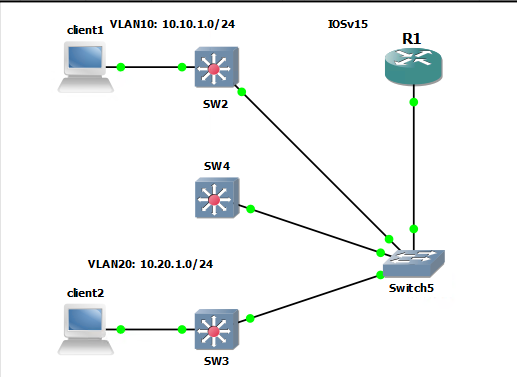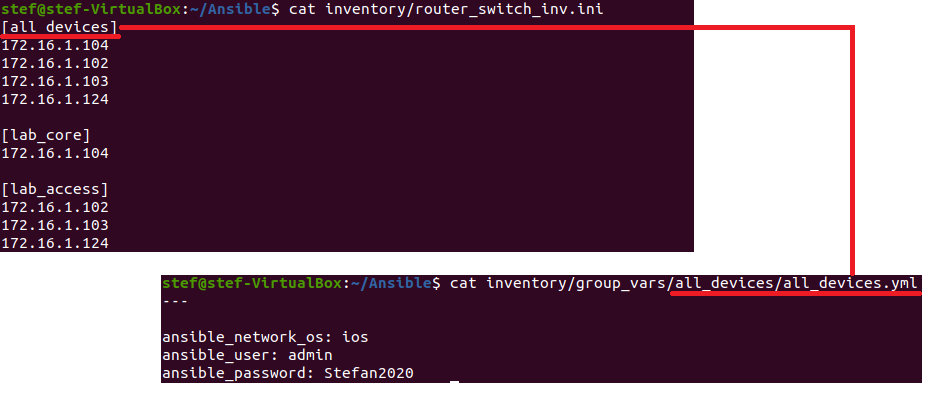Basic how to guide to Install Ansible quickly on Ubuntu. The full guide for Ubuntu is here.
Installation
|
0 1 2 3 4 |
sudo apt-add-repository ppa:ansible/ansible sudo apt update sudo apt install ansible |
Create the Inventory to Test
This file is named router_switch_inv.ini in my lab.
|
0 1 2 3 4 5 6 7 8 |
[lab_core] 172.16.1.104 [lab_access] 172.16.1.102 172.16.1.103 172.16.1.124 |
Test Topology
With three lines and a small file it is very simple to start interacting with network devices.

|
0 1 2 3 4 5 |
R1: 172.16.1.104 S2: 172.16.1.102 S3: 172.16.1.103 S4: 172.16.1.124 |
|
0 1 2 3 4 5 6 7 |
$ ansible -i ./router_switch_inv.ini --list-hosts all hosts (4): 172.16.1.104 172.16.1.102 172.16.1.103 172.16.1.124 |
|
0 1 2 3 4 5 6 7 8 9 10 11 12 13 |
$ ansible 172.16.1.104 -i ./router_switch_inv.ini -m raw -a "show ip int br" -u admin -k SSH password: 172.16.1.104 | CHANGED | rc=0 >> Interface IP-Address OK? Method Status Protocol FastEthernet0/0 172.16.1.104 YES NVRAM up up Ethernet1/0 unassigned YES unset up up Ethernet1/0.10 10.10.1.1 YES manual up up Ethernet1/0.20 10.20.1.1 YES manual up up Ethernet1/1 unassigned YES unset administratively down down Ethernet1/2 unassigned YES unset administratively down down Ethernet1/3 unassigned YES unset administratively down down Shared connection to 172.16.1.104 closed. |
Inventory File in Depth
The ansible inventory file can be specified or a default location can be configured in the /etc/ansible/ansible.cfg file by adding the following lines.
|
0 1 2 3 |
[defaults] inventory = /home/stef/Ansible/inventory/router_switch_inv.ini |
Another change that can be made is to include group variables for things like usernames/passwords, device types and the ansible vault.
The inventory file looks like this, with a new group called “all_devcies”. This group holds all of my devcices and I can now apply variables to them. I could have created two files based off the group names.
|
0 1 2 3 4 5 6 7 8 9 10 11 12 13 14 15 |
$ cat inventory/router_switch_inv.ini [all_devices] 172.16.1.104 172.16.1.102 172.16.1.103 172.16.1.124 [lab_core] 172.16.1.104 [lab_access] 172.16.1.102 172.16.1.103 172.16.1.124 |
The group_vars file is a yaml file and needs to be named the same as the group. Mine will need to be called all_devices.yml
The diagram will explain how it must look.

Below is a good example showing how I have the files structured.
|
0 1 2 3 4 5 6 7 8 9 10 11 12 13 14 15 16 17 18 19 20 21 22 23 24 25 26 |
$ tree . ├── default ansible hosts ├── inventory │ ├── group_vars │ │ └── all_devices │ │ └── all_devices.yml │ ├── router_switch_inv.ini │ └── usernames.txt ├── output │ ├── 172.16.1.102_iosfacts2.json │ ├── 172.16.1.103_iosfacts2.json │ ├── 172.16.1.104_iosfacts2.json │ └── 172.16.1.124_iosfacts2.json └── playbooks ├── pb1_basic.yml ├── pb2_ioscommand.yml ├── pb3_magicvars.yml ├── pb4_iosfacts.yml ├── pb5_iosfacts2.yml ├── pb6_iosconfig.yml ├── pb7_multitasks.yml └── pb8_multiplays.yml 5 directories, 16 files |
Now when running commands there isn’t a need to specify the inventory file or the credentials. The device type being ios is used for the ios module.
